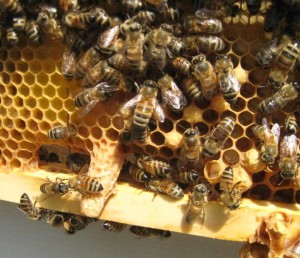Nicot Day 15
Wow – the weather changed and then some! I’ve started receiving swarm calls and at least 2 of my hives have swarmed. I actually caught the marked queen from one of my hives and Nuc’d her, but she actually swarmed (with most of the bees in the Nuc) anyway! That’s simply amazing. I have never had that happen before. Taking a wild guess, I suppose they were literally getting ready to swarm while I was inspecting the hive. When I moved the bees to the Nuc (to make the parent hive think she had swarmed), they simply went ahead and swarmed! Ha. Oh well.
Besides creating a ton of Nucs (some with eggs, some with swarm cells), I have been fine tuning my queen rearing program. Over the weekend (actually on Friday), I hit Day 15 of the Nicot System. This is the day when you have capped queen cells that are about 2 days from hatching. On Day 14, you create a bunch of queenless Nucs to receive these cells. It is said that a bunch of bees without a queen will pretty much always accept a queen cell that was started by a queenless hive and finished by a queen-right hive. We shall see.
I miscounted my cells by 4 (it’s not that easy to count them, as the bees swarm the things when you remove the cell bar), so I had to create 4 Nuc’s ‘on the fly’ and give them cells. It will be interesting to see if the bees accept them (or kill them and go about raising their own queens.) I am feeling very comfortable with the Nicot system, using my double-deep setup (which I only have a few of, just for queen rearing.) If you stick to the schedule, the success rate is pretty good (I’d say about 50% – maybe that’s not good, but it’s more queens than I can handle.) I plan to make another run of it next weekend, this time providing some to the members of the East Richmond Beekeeping Association.
The toughest part, without a shadow of a doubt, is creating those queenless Nuc’s. It requires a ton of resources (I have 2 queen castles, that only require 2 or 3 frames, but everything else is a full, 5 frame Nuc.) Since I am building Nuc’s at the same time, I really had to push to get my Nuc’s created. When I create a Nuc, I pretty much just carve a piece off of a larger, parent hive. When I’m done, they typically do not miss a beat – sometimes spawning one, two and sometimes three more Nuc’s before it’s over. Most of the time, they (the parent hive) still have a great honey crop. But, this past weekend I had to cut deeply into several hives. I plan to pay special attention to these hives just to make sure they get back to critical mass and store enough honey for the Winter.
But, this weekend, I plan to build a few more of these ‘queen castles’ – I think I will shoot for 2 frames per section and give that a shot. I really just need this second batch to mate, so I don’t think this will be a problem. But, I can’t fathom how often I’ve said that and been wrong…

